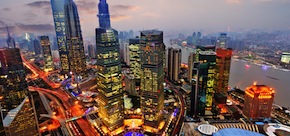When I told people I was off to Shanghai for a long weekend, they looked at me as though I was crazy. Why take such a long flight to go to such a busy city just for three or four days?
OK, a little longer would have been nice, but when relying on friends to look after my teenage son and dog, you’ve got to take what you can.
However, I was surprised to note that four days in Shanghai is just the right amount of time, if you’re prepared. For those considering a quick stop in Shanghai as part of a longer trip, or as a special weekend away, here are six tips to help you survive this city with 24 million inhabitants.
- Take a taxi from the airport. Yes, the Maglev train going at 300km an hour and taking only seven minutes is exciting, but it only goes to one station and from there you will have to transfer to the main subway system or take a taxi anyway. Given that you’ve probably just come off a 10-hour flight, don’t know the city that well and most likely don’t speak the language, a taxi is the best option. It should cost you about 150 RMB, approx. $30, and take about an hour. If possible, have the address of where you’re staying in Chinese, and carry this with you throughout your stay, it will make things much easier. By all means take the Maglev on your return to the airport. You don’t see much, but it does go fast.
Shanghai Maglev Train. - Make friends with the concierge at your hotel. Shanghai isn’t really a tourist city, but there’s plenty to see and do if you know where to go. There is a tourist centre on the Bund, but for real insider knowledge, ask your concierge for information on the best places to visit. Also, while a few places will be able to provide someone who speaks English, this isn’t common to all, so if you want a dinner reservation, make it through your hotel.
- Master the subway. I was told that the subway system in Shanghai was efficient but difficult to master as it didn’t have signs in English. Perhaps things have changed, but this is nonsense. Signs are clear and concise, in both languages I believe and the ticket machines have an English-language option. All lines are numbered, so simply find the line you want and if you need to transfer to another, that’s pretty easy too. If you’re still unsure, ask at your hotel for an English-language subway map as back up. A 24-hour ticket is only 18RMB, about $3.30. The trains themselves have illuminated maps which tell you which stop is next and which door to get out.
Interactive subway map. - Find a landmark. Tourist maps of Shanghai are missing many details, including the names of several roads. To make sure you don’t get lost, identify a landmark in the area and use it as your point of reference. There are tourist safety guides at most of the major junctions, but they don’t speak much English, so you’re effectively on your own. Also, I was told before I went that Shanghai was easy to walk around. This is true in part, as the streets are wide, clean and well maintained, but it’s a huge city and is much bigger than it looks on maps.
- Don’t be afraid to venture past the large shopping centres. As with any large city you do have to be on your guard for pick pockets and petty crime, but Shanghai is a safe destination. I can heartily recommend some of the areas which are known for their little side streets and back alleys, such as Xintandi and Dapuqiao. Both have quaint little shops offering souvenirs, and you won’t be hassled as you browse.
- Don’t be disappointed by the tourist sites. As I said before, Shanghai is great for visitors, but not really international tourists who may have been impressed by other cities. The Bund is fun for five minutes and the Pearl TV Tower should only be visited on a clear day and not at the weekend when it’s heaving with Chinese visitors. People’s Square is OK, the most peculiar thing is the little notes pinned to umbrellas at the entrance, which are actually parents trying to find a match for their children, not find missing persons as I first thought. Yuyuan Gardens are indeed pretty, but at the weekend they are overrun by people taking on the treasure hunt challenge and also local businesses trying to sell their wares.
Not to be missed:
Xiaolongbao – tasty little dumplings, usually filled with pork and a burst of steaming hot soup. Although sold all over the city, some of the best can be found at the Din Tai Fung restaurant chain.
Jazz at the Waldorf Astoria. Although not as grand as its New York counterpart, the Waldorf Astoria is a great place to catch an after-dinner drink and listen to possibly the oldest jazz band you’ll ever come across, in the Long Bar from 9.30pm. Although this may seem early for an after-dinner drink, in Shanghai you’ll find most people eat early.
Tai Chi at People’s Square. While the square itself is OK, the Chinese practising the ancient art of Tai Chi is incredibly relaxing and therapeutic to watch, or even join in if you’re feeling flexible. Most Tai Chi takes place early in the morning, about 630am, but you can find small groups practicing throughout the day.

